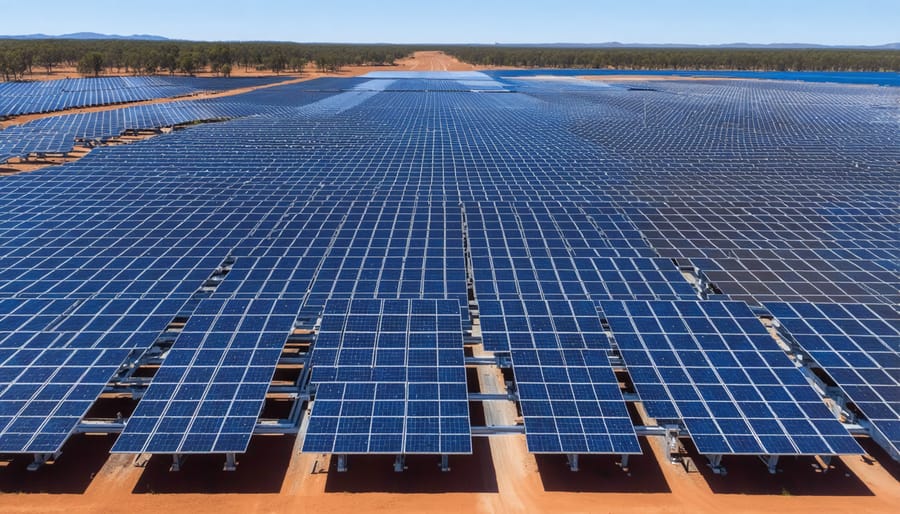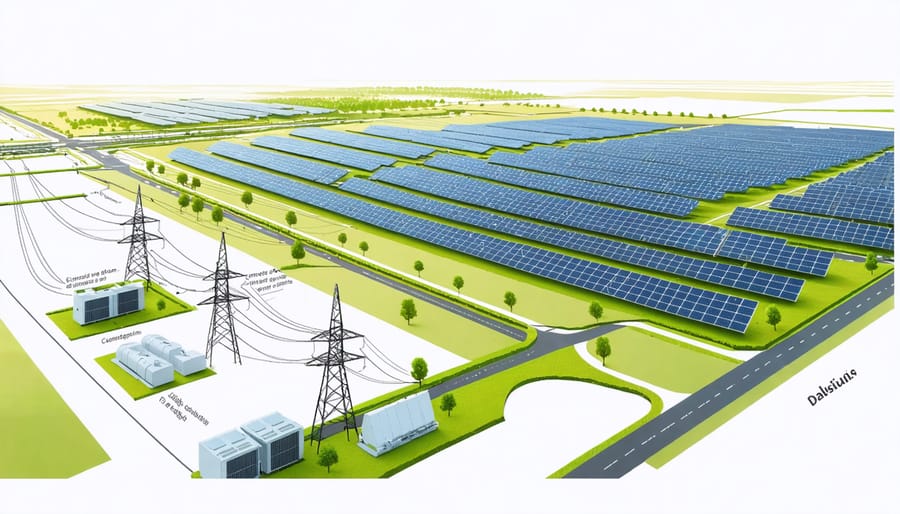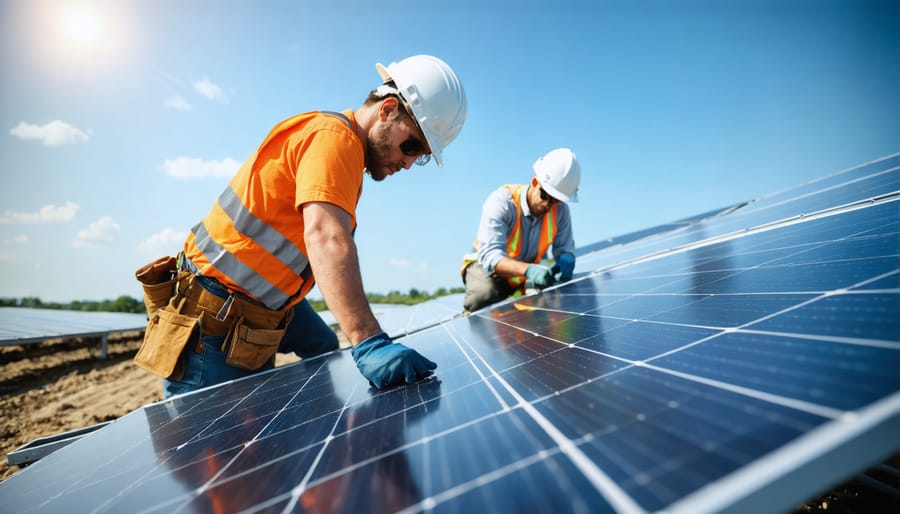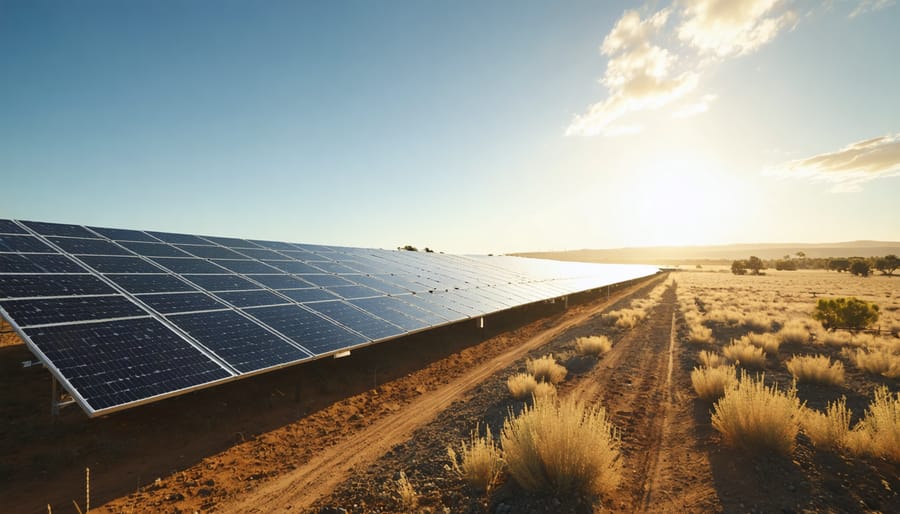Utility-scale solar power stands at the forefront of Australia’s renewable energy revolution, transforming vast sunbaked landscapes into clean power generators that rival traditional fossil fuel plants in both scale and efficiency. These massive solar installations, typically exceeding 100 megawatts in capacity, are reshaping our national energy landscape while working in harmony with emerging renewable energy storage technologies to ensure reliable, round-the-clock power supply.
Unlike rooftop solar installations, utility-scale projects leverage economies of scale to deliver clean electricity at costs competitive with conventional power sources. These solar farms, spanning hundreds of hectares across Australia’s sun-rich regions, represent a crucial stepping stone toward our nation’s renewable energy targets and carbon reduction commitments.
The impact extends beyond environmental benefits – utility-scale solar projects create thousands of jobs, stimulate regional economies, and provide energy security for communities across the continent. As technology advances and installation costs continue to decline, these massive solar installations are becoming increasingly central to Australia’s energy future, proving that sustainable power generation can be both environmentally responsible and economically viable.
The Power of Going Big: Understanding Utility-Scale Solar

Key Components and Infrastructure
Utility-scale solar facilities rely on several crucial components working together seamlessly. At their heart are vast arrays of photovoltaic (PV) panels, typically mounted on sophisticated tracking systems that follow the sun’s path throughout the day, maximising energy capture. These tracking systems can boost energy yield by up to 25% compared to fixed installations.
The solar arrays connect to power inverters that convert DC electricity to AC power suitable for grid distribution. These inverters, along with transformers, form the backbone of the power conversion system. Modern facilities also incorporate advanced monitoring systems and weather stations to optimise performance and predict energy generation.
Energy storage solutions, particularly large-scale batteries, are becoming increasingly common in Australian solar farms. These systems help manage intermittency and enable power dispatch during peak demand periods. Supporting infrastructure includes robust security systems, maintenance buildings, and sophisticated grid connection equipment.
The facility’s control room houses SCADA systems for real-time monitoring and operation, while comprehensive telecommunications networks ensure seamless integration with the broader power grid. Access roads and fencing complete the essential infrastructure, ensuring safe operation and maintenance of these renewable powerhouses.
Scale and Efficiency Benefits
Utility-scale solar installations offer remarkable advantages through their sheer size and operational efficiency. These large-scale projects typically generate electricity at costs 30-40% lower than residential solar systems, making them a game-changer for Australia’s renewable energy landscape. The efficiency gains come from several factors, including bulk purchasing power for equipment, standardized installation processes, and optimized maintenance schedules.
A single utility-scale solar farm can power tens of thousands of homes, delivering clean energy at a fraction of the space required for distributed residential systems. For example, the Darlington Point Solar Farm in New South Wales, spanning 1,000 hectares, generates enough electricity to power over 115,000 homes while benefiting from advanced tracking systems and automated cleaning solutions.
These installations also benefit from sophisticated monitoring systems and economies of scale in maintenance operations. Centralized management means faster response times to technical issues and more efficient resource allocation. Additionally, utility-scale projects can negotiate better grid connection arrangements and power purchase agreements, leading to more stable energy prices for consumers and better returns on investment for developers.
Grid Integration Challenges and Solutions

Storage Solutions and Grid Stability
As utility-scale solar installations grow across Australia, the integration of advanced energy storage breakthroughs becomes increasingly crucial. Battery technology, particularly lithium-ion systems, has emerged as a game-changer for managing solar power’s intermittent nature. These storage solutions enable solar farms to deliver consistent power even after sunset, effectively turning solar into a 24/7 energy resource.
Modern grid stability solutions combine multiple technologies, including pumped hydro storage, advanced batteries, and smart grid management systems. The Western Australian Goldfields region showcases this brilliantly, where utility-scale solar projects paired with battery storage systems provide reliable power to remote mining operations while maintaining grid stability.
Virtual power plants (VPPs) are revolutionizing how we manage solar energy distribution, aggregating multiple storage systems to create a coordinated network that responds to grid demands in real-time. This sophisticated approach helps balance supply and demand, reduces the risk of blackouts during peak periods, and maximizes the economic value of solar investments.
The integration of artificial intelligence and machine learning further enhances these systems, predicting energy needs and optimizing storage capacity to ensure seamless power delivery while maintaining grid frequency and voltage within safe operating ranges.
Smart Grid Technologies
Smart grid technologies are revolutionising how utility-scale solar integrates with Australia’s power network. These advanced systems act as the brains of our modern electricity infrastructure, enabling seamless communication between solar farms, energy storage facilities, and consumers.
At the heart of smart grid management are sophisticated monitoring and control systems that predict solar generation patterns based on weather forecasts and historical data. This predictive capability allows grid operators to balance supply and demand more effectively, reducing the impact of solar intermittency on the network.
Real-time data analytics and automated response systems help maintain grid stability by adjusting power flow instantly when cloud cover affects solar generation. In South Australia, for example, smart inverter technologies are enabling solar farms to provide essential grid services like voltage support and frequency regulation, previously only available from conventional power plants.
Energy storage integration is another crucial aspect of smart grid management. Advanced control systems coordinate between battery storage facilities and solar farms, storing excess energy during peak production and releasing it when needed. This sophisticated orchestration ensures reliable power supply even after sunset.
Perhaps most impressively, smart meters and demand response programs are enabling consumers to participate actively in the grid ecosystem. By automatically adjusting consumption patterns based on solar availability, these systems help maximise the use of clean energy while maintaining grid stability.
Environmental and Economic Impact
Carbon Reduction and Land Use
Utility-scale solar installations play a crucial role in Australia’s carbon reduction strategy, offering significant environmental benefits while requiring careful consideration of land use. These large-scale solar farms can offset thousands of tonnes of carbon emissions annually, with a typical 100MW facility preventing approximately 150,000 tonnes of CO2 from entering the atmosphere each year – equivalent to taking 45,000 cars off the road.
Smart land management practices are increasingly being incorporated into solar farm designs. Many Australian solar facilities now implement dual-use strategies, such as sheep grazing between panel rows, which maintains vegetation and supports local agriculture. This approach, known as agrivoltaics, maximizes land efficiency while preserving agricultural productivity.
Additionally, strategic site selection focuses on utilizing previously cleared or degraded land, minimizing environmental impact. Solar developers are also implementing native vegetation corridors and wildlife passages, creating habitat networks that support local biodiversity. These practices demonstrate how utility-scale solar can contribute to both emissions reduction and sustainable land management, particularly in regional areas where most large-scale installations are located.
Job Creation and Economic Growth
Utility-scale solar projects are proving to be powerful economic drivers across Australia, creating thousands of jobs and stimulating local economies. During construction, large solar farms typically employ 200-400 workers, with roles ranging from civil engineers and electricians to general laborers and project managers. Once operational, these facilities provide long-term employment opportunities for maintenance technicians, operations managers, and support staff.
The ripple effect extends beyond direct employment. Local businesses benefit from increased activity during construction, with accommodation providers, restaurants, and suppliers experiencing significant upticks in revenue. In regional communities like Broken Hill and Moree, solar projects have breathed new life into local economies, creating sustainable career pathways for residents who previously faced limited employment options.
Training programs associated with utility-scale solar developments are also building valuable skills within communities. TAFE institutions and renewable energy organizations are partnering to deliver specialized courses, preparing workers for the growing solar industry. This investment in human capital ensures long-term economic benefits while supporting Australia’s transition to renewable energy.
For every 100 megawatts of installed solar capacity, studies indicate approximately 40-50 ongoing jobs are created, making utility-scale solar a significant contributor to Australia’s renewable energy workforce.

Utility-scale solar stands as a cornerstone of Australia’s green energy revolution, offering a proven pathway to a sustainable future. Our sun-drenched continent possesses unmatched potential for large-scale solar deployment, and the time to act is now. By supporting utility-scale solar projects through investment, policy advocacy, and community engagement, we can accelerate Australia’s transition to renewable energy while creating thousands of jobs and strengthening our energy independence. The success stories we’ve witnessed across the country demonstrate that utility-scale solar is not just environmentally responsible – it’s economically smart. Let’s embrace this opportunity to position Australia as a global leader in renewable energy, ensuring a cleaner, more prosperous future for generations to come.

